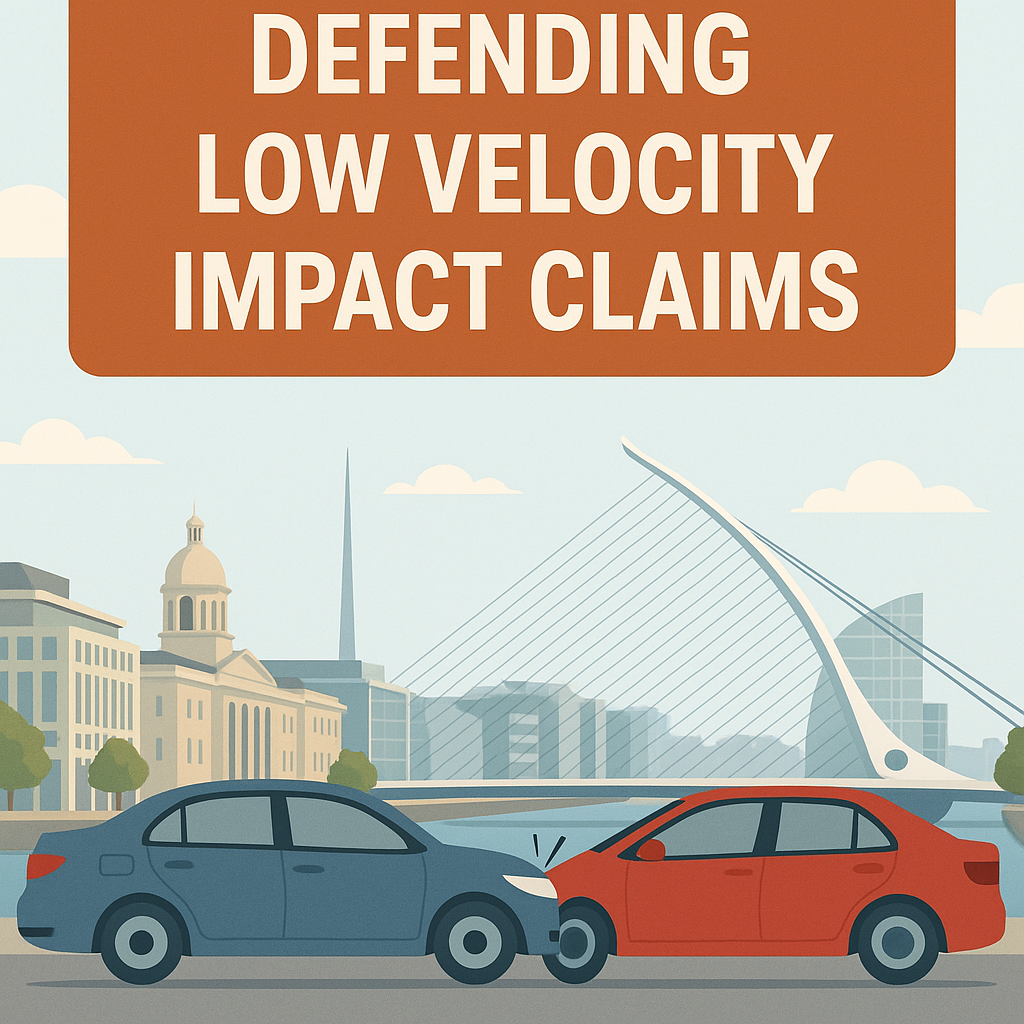Introduction
Low Velocity Impact (LVI) claims, despite involving seemingly minor collisions, often escalate into contentious legal disputes over causation—posing a persistent challenge for insurers and defence solicitors across Ireland. These cases typically arise from road traffic accidents with little or no visible vehicle damage, yet claimants frequently allege soft tissue injuries, particularly of the whiplash variety.
For claimants, securing fair compensation for real injuries is a legal and moral right and Lacey Solicitors entirely supports that right. But for insurers and defence solicitors, there is an equally important duty: to thoroughly investigate claims, ensure that policyholders are protected, and guard against exaggerated or unfounded claims.
The central legal issue is not whether a collision occurred, but whether it was capable of causing the injuries claimed. Defending such cases successfully requires a disciplined strategy based on early factual investigation, expert scientific input, and a deep understanding of biomechanics and legal precedent.
What Is a Low Velocity Impact Claim?
An LVI claim is defined by a collision where damage to the vehicles is minimal or negligible. The defendant typically accepts that the incident occurred but challenges whether the forces involved were sufficient to cause the alleged injuries.
Commonly, these cases involve complaints of neck, back, or shoulder pain and arise from rear-end “shunt” type impacts. The defence position is that the physical forces involved were too low to displace vehicle occupants enough to cause injury.
This is not a denial of the accident or the injury, but rather a focused challenge on the issue of causation, supported by biomechanical, medical, and engineering evidence. Causation is a matter of expert analysis and is not assumed simply from the occurrence of a collision.
The Role of the Insured’s Statement
A robust defence for insurers begins with a comprehensive and accurate statement from the insured party. Their first-hand account helps establish key facts such as:
-
Vehicle speeds
-
Braking and road conditions
-
Location and point of impact
-
Perceived severity of the collision
This account forms the basis for subsequent engineering analysis and may become critical evidence in litigation.
Importantly, insurers must remember that minimal damage does not always equate to minimal force. Past cases have demonstrated that superficial damage can mask significant force transfer, making early factual accuracy crucial.
The Tow Bar Factor: Misleadingly Minor Damage
Tow bars present a unique issue in LVI claims. When a vehicle is struck directly on a tow bar, the damage to the vehicle may be minor—but the energy transfer can be substantial.
Unlike modern bumpers, which are designed to absorb and dissipate collision energy, tow bars transmit the force directly into the chassis. This can bypass energy absorption mechanisms and lead to greater force being transferred to vehicle occupants.
As a result, even seemingly trivial accidents involving tow bars should be investigated with care. Where injury is alleged despite limited visible damage, engineering evidence is essential to assess whether the impact forces were, in fact, substantial.
Biomechanics and the Delta V Threshold
At the heart of scientific analysis in LVI cases lies the concept of Delta V—the change in velocity a vehicle undergoes during impact. This metric helps quantify the potential for injury.
Studies, including those by the International Research Committee on the Biomechanics of Impact (IRCOBI) and GBB (UK) Ltd, have established key thresholds:
-
Below 3 mph Delta V: Occupant movement is comparable to routine activities like sitting down or walking; injury is highly unlikely.
-
Between 3–5 mph: Injury is possible, though not presumed.
-
Above 5 mph: Increased likelihood of soft tissue injury.
However, injury potential also depends on multiple variables, including:
-
Seat design
-
Vehicle construction
-
Occupant awareness and bracing
-
Age, gender, and pre-existing conditions
-
Occupant posture at the time of impact
These findings support the defence argument that not all impacts, even if acknowledged, have the biomechanical potential to cause the injuries alleged.
Medical Evidence and Engineering Reports
Claimants often produce medical reports confirming injury. Yet many such reports rely heavily on the claimant’s own account and do not critically assess whether the incident mechanics support the diagnosis.
For a credible defence, insurers should instruct medical experts with experience in:
-
Musculoskeletal injury diagnosis
-
Biomechanical injury thresholds
-
Evaluating causation based on incident specifics
Similarly, engineering experts should assess vehicle damage, calculate Delta V, and determine the likelihood of occupant displacement. When medical and engineering expertise are integrated early, they form a powerful evidentiary foundation to challenge causation effectively.
Witness Testimony and Its Legal Impact
Independent witness statements can influence a court’s perception of impact severity. For example, a witness who describes hearing a loud “bang” may bolster the claimant’s version of events.
However, aural impressions do not always correlate with force transmission. A loud sound may result from materials striking or crumpling but may not reflect biomechanical force levels.
Defence teams should:
-
Interview witnesses early
-
Assess the witness’s vantage point and line of sight
-
Evaluate their ability to accurately perceive impact force
The aim is to determine whether the witness is truly independent and whether their testimony aligns with the physical evidence.
Lacey Solicitors Insurance Lawyers Recommendations
A proactive, evidence-based approach is key to defending LVI claims. Insurers are advised to:
-
Obtain prompt, detailed statements from the insured party.
-
Investigate vehicle damage thoroughly, paying close attention to structural components such as tow bars.
-
Instruct experienced medical and biomechanical experts early to assess the causation of injuries.
-
Critically evaluate all witness testimony for accuracy, relevance, and independence.
-
Integrate factual, engineering, and medical evidence into a coherent and persuasive defence strategy.
Conclusion
Low Velocity Impact claims remain a legally and scientifically complex area of personal injury litigation, especially where physical damage is minimal. Each case turns on its unique facts, but insurers can defend these claims effectively by focusing on early investigation, rigorous expert analysis, and strategic coordination.
In our insurance defence practice across Belfast and Dublin, we support insurers in navigating the technical and legal challenges of LVI claims. By leveraging biomechanical science alongside targeted litigation strategies, we deliver results that protect our insurance client’s and their policyholders and uphold the integrity of the insurance system.
Need Support on a Suspected Low Velocity Impact Claim?
If you’re handling a suspicious or exaggerated LVI claim, our team can help. We provide:
-
Tactical guidance
-
Expert coordination
-
Litigation strategy
-
Comprehensive defence reports
We serve insurers throughout the entire island of Ireland, delivering robust, evidence-driven defences to minimise risk and exposure.
Contact our Insurance Defence Team today using our online contact portal for tailored support.








